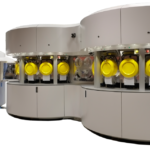Encapsulation of Small Extracellular Vesicles into Selectively Disassemblable Shells of PEGylated Metal‐Phenolic Networks
Advanced Healthcare Materials, EarlyView.

Small extracellular vesicles (sEVs) are encapsulated into protective shells composed of metal-phenolic networks (MPNs) and secondary poly(ethylene glycol) layers. This surface modification approach enhances the storage stability of sEVs while maintaining their integrity and functionality. The shells can be selectively disassembled under mild conditions. Overall, this rapid, efficient, and reversible coating technique broadens the potential of sEVs in diverse applications.
Abstract
Small extracellular vesicles (sEVs) are cell-derived particles used for intercellular communication in living organisms that have gained great interest from researchers for their use as drug carriers and diagnostic agents. However, the isolation and storage of sEVs lead to issues including lipid membrane disruption, protein denaturation, and nucleic acid degradation. Herein, a surface functionalization strategy is reported for encapsulating single sEV into selectively disassemblable protective shells composed of metal-phenolic networks (MPNs) post-modified with poly(ethylene glycol) (PEG). Disassemblable MPN shells can be rapidly deposited on sEVs in a one-step manner and post-modified with PEG. These coatings enhance the colloidal stability of sEVs and protect them against harsh storage conditions, while the non-covalent and selectively disassemblable nature of the MPN shell allows recovery after storage without compromising their surface integrity and functionality. It is demonstrated that various triggers, such as pH adjustment, competitive chelation, and redox reactions, can be used to disassemble the MPN shell, thereby offering widely adoptable strategies depending on the target applications. This approach potentially overcomes conventional challenges associated with sEV processing and storage and may contribute to reducing cold-chain requirements and transportation costs of future sEVs-based therapeutics and diagnostics.

















































































































































